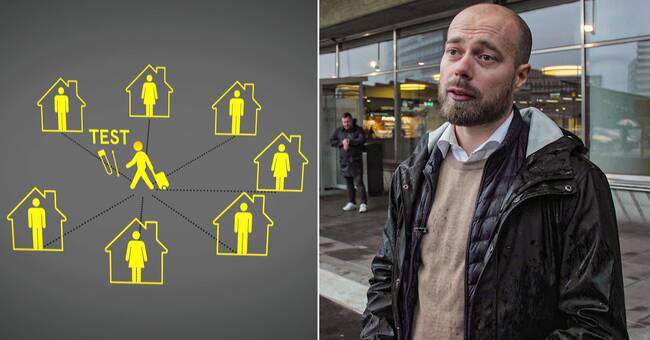At the end of February and the beginning of March, ski area after ski area in the Alps will be placed on the Public Health Agency's list of risk areas for the coronavirus.
The strategy is to stop the infection at the border, by returning travelers who develop symptoms and infection tracking is done by people with whom the traveler has been in contact.
This will end in mid-March, when the coronavirus has entered society.
After the sports holiday, state epidemiologist Anders Tegnell considers the strategy a success.
- We caught a lot of those who were infected by the Italian travelers.
We broke the chains of infection.
Had we not done so, we would have had a completely different situation in Sweden today, says Anders Tegnell to Assignment review at a press conference on March 23.
Finds less than two contacts per infected
Assignment review has mapped how many travelers the regions caught before stopping testing.
The question has been asked to all 21 regions, 16 have answered.
A total of 677 travelers were caught, the Stockholm region accounts for 263 of them.
With the help of infection tracing, the Stockholm Region finds 436 people who have had contact with the infected and is encouraged to stay at home, less than two contacts per infected person.
- It is difficult to relate what is a lot and what is a little in these contexts with a completely new disease.
But it was still the case that we recommended those who had symptoms to try then, says Maria Rotzén Östlund, acting infection control doctor Region Stockholm.
If you came from the right area?
- If you came from the right area, exactly.
"There was no testing"
Initially, it is mainly northern Italian regions that are put on the list of risk areas.
Austria later turns out to be a hotbed of infection, but Anders Tegnell has claimed that they did not receive information about the spread of the infection there in time.
March 4 comes a warning from the Public Health Agency's equivalent in Iceland, according to reports Assignment review has received.
They have found a total of 26 covid-infected ski tourists, eight of whom have been in the Austrian Ischgl.
But it takes five days before Austrian Tyrol is put on the Public Health Agency's list of risk areas to test from.
- We wanted to get a receipt that it was not just a coincidence that they found a case.
Iceland is a small country with quite a few people.
It could have been a coincidence that you saw some there, says Anders Tegnell.
"Quarantined myself"
Already the day after Austria ends up on the list, March 10, the Stockholm Region stops testing travelers with symptoms - the strategy is changed to instead catch infected people early in care.
Four days later the ski traveler Johan at Arlanda, returned from the ski resort Ischgl.
- It feels like I am one of the examples where you really were there when it was at its worst and got no information on how to behave and there was no tracking.
A few hours after Johan comes home, he starts to have chills, fever and headaches.
He stays in bed and calls 1177 - but says that there is no interest in testing him.
- Now I put myself in quarantine.
But several people I traveled with could just as easily have been infected.
They went on with their normal lives because they have no symptoms.
In July, Johan tests positive for antibodies.
“It has been a mixed mix”
An estimated 80,000 tourists came to Sweden from Austria during February and March, according to the Travel Barometer.
Anders Tegnell tells Uppdrag granskning that it was not the virus strains that Iceland saw that caused the spread in Sweden.
But you have said that Austria contributed greatly to the spread of infection?
- I do not know, because the tribes we have now reported, they are tribes from Great Britain, from the United States, from France and elsewhere.
So it has been a mixed mix.
The Swedish Public Health Agency has conducted a random survey which shows that the two virus variants that continued to spread in Sweden have "certain differences" from the variants imported from Austria and Italy, which strengthens the hypothesis that the infection came from several parts of the world, according to the agency.

